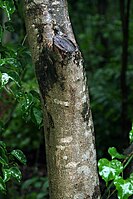Lysiloma divaricatum
| Lysiloma divaricatum | |
|---|---|

| |
| Scientific classification | |
| Kingdom: | Plantae |
| Clade: | Tracheophytes |
| Clade: | Angiosperms |
| Clade: | Eudicots |
| Clade: | Rosids |
| Order: | Fabales |
| Family: | Fabaceae |
| Subfamily: | Caesalpinioideae |
| Clade: | Mimosoid clade |
| Genus: | Lysiloma |
| Species: | L. divaricatum
|
| Binomial name | |
| Lysiloma divaricatum (Jacq.) J.F.Macbr.
| |
| Synonyms[2] | |
| |
Lysiloma divaricatum is a flowering tree native to Mexico and Central America. Common names include mauto, quitaz, and tepemesquite in Mexico, quebracho in Honduras, Mexico, and Nicaragua, and quebracho negro, tepemisque, and yaje in El Salvador.[2]
Description
Lysiloma divaricatum is typically a small to medium-sized tree, densely branched, with an open spreading crown up to 15 meters high.[2]
Distribution and habitat
Lysiloma divaricatum ranges from northern Mexico to Costa Rica.[2]
It is found in tropical and subtropical dry deciduous forest, mixed pine forest, and occasionally in desert scrub with cactus. It ranges from sea level up to 1100 meters elevation, and occasionally up to 1750 meters. It is often found on slopes growing on volcanic and sandy clay soils.[2]
In Baja California it is commonly associated with Caesalpinia pannosa. Elsewhere it is often found with other dry forest species like Chloroleucon mangense, Leucaena macrophylla and Senna mollissima, along with species of Acacia, Parkinsonia, Calycophyllum, Mimosa, Myrospermum, and Burseraceae.[2]
Gallery
-
Seed pods and flowers
-
trunk
Conservation
The population is considered stable, and the species is assessed as Least Concern due to its wide distribution, large population, and absence of major threats.[1]
References
- ^ a b Botanic Gardens Conservation International (BGCI) & IUCN SSC Global Tree Specialist Group. 2019. Lysiloma divaricatum. The IUCN Red List of Threatened Species 2019: e.T146774259A146774261. https://dx.doi.org/10.2305/IUCN.UK.2019-2.RLTS.T146774259A146774261.en. Accessed on 25 March 2022.
- ^ a b c d e f "Lysiloma divaricatum (Jacq.) J.F.Macbr." Plants of the World Online, Kew Science. Accessed 25 May 2022. [1]



